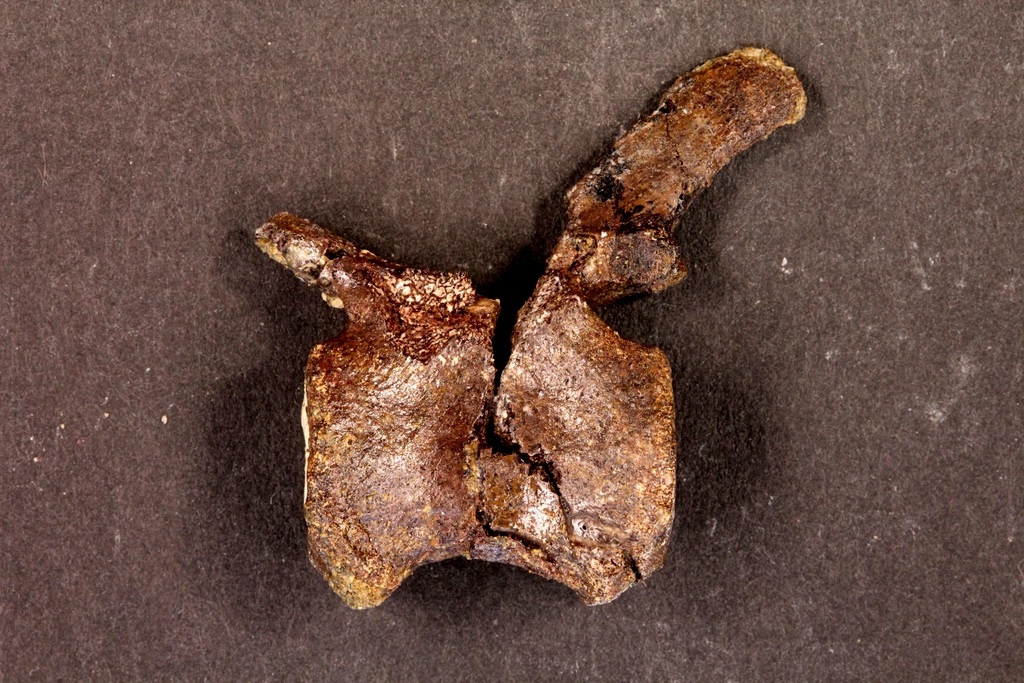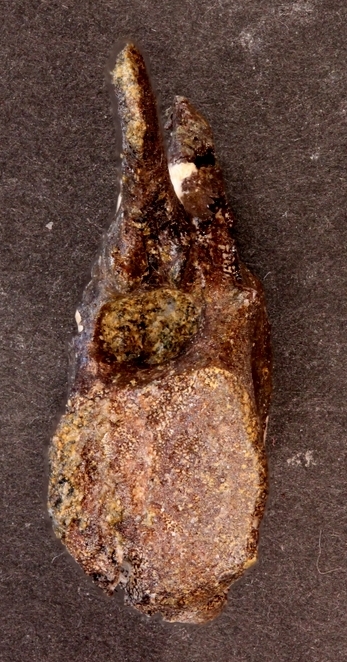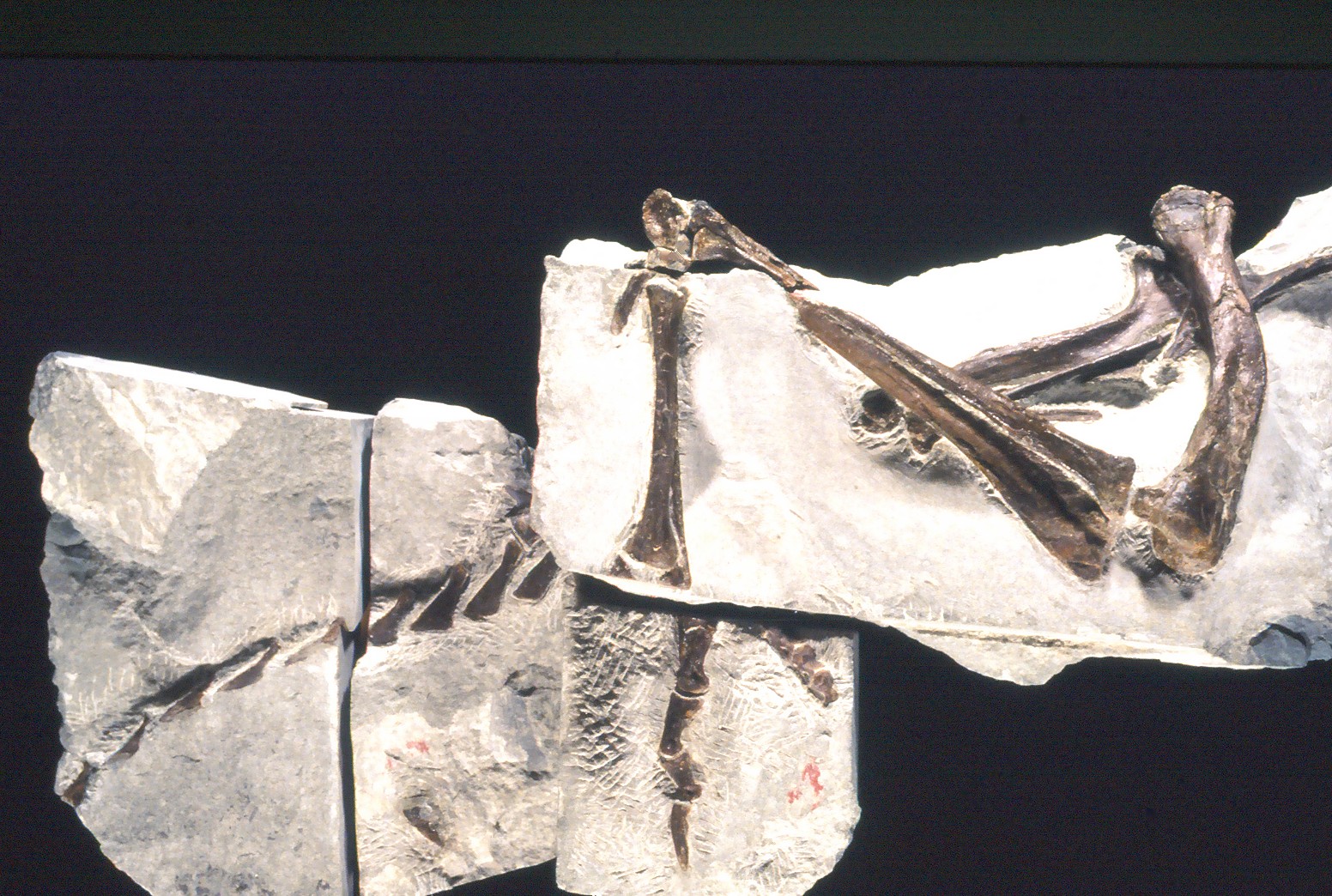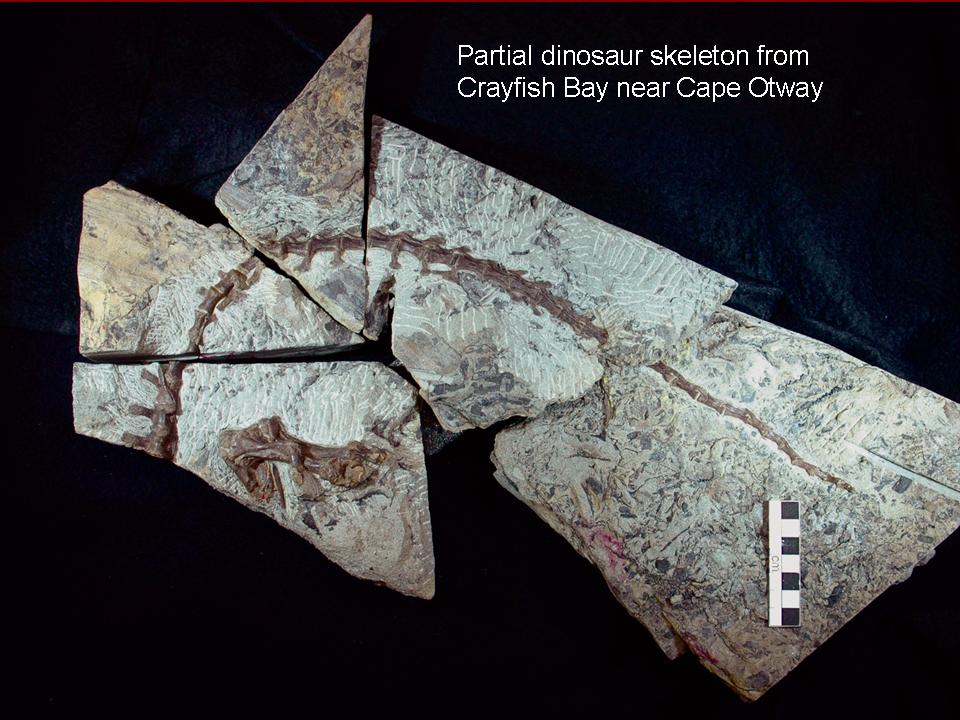Fossil Preparation 4
PREPARATION OF A SMALL ORNITHOPOD DINOSAUR VERTEBRA FROM ERIC THE RED WEST SITE 2016 FIELD TRIP
By Lesley Kool
Bone #278, discovered during the Eric the Red West 2016 field trip, was labelled "Vertebra from Hole", indicating that it had been found in the excavation pit. It was in two parts and sufficiently exposed to identify as a vertebra. Unfortunately, some of the middle part of the vertebra had been lost during excavation, but the rest of the vertebra was well preserved (Image #1). A small amount of preparation on the back part of the vertebra revealed a well preserved neural spine (image #2), but it was too fragile to remove without embedding it in Carbowax (image #3). This process involved surrounding the rock in a wall of plasticine and pouring melted Carbowax (Polyethylene glycol) into the plasticine mould. Once the Carbowax had hardened, the plasticine was removed (image #4) and the rest of the rock was removed using a pneumatic ARO air-scribe tool. After all the rock was removed, the Carbowax was slowly melted (as described in previous articles - see Fossil Prep 2) and the vertebral fragment was freed from the wax.
The second part of the vertebra was easier to remove from the rock (image #5) and did not require the use of Carbowax. The two halves were carefully glued back together again (image #6) and the missing bone was replaced with putty to help stabilise the bone. The overall shape of the finished vertebra indicates that it is from the tail of a small dinosaur.
The cross-section through the centrum (the cotton-reel shaped lower part of the vertebra) revealed solid, compact bone indicating that the vertebra did not come from a theropod dinosaur, which had large air pockets inside the vertebra, similar to birds. This vertebra belonged to a small ornithopod dinosaur - the most common dinosaur found in the Victorian Early Cretaceous rocks.
To date four ornithopod dinosaur skeletons have been discovered in Victoria: three from the Otway Group to the south west of Melbourne and one from the Strzelecki Group to the south east of Melbourne. In 1987 a small ornithopod dinosaur skeleton was discovered at Dinosaur Cove, a few kilometres west of the Eric the Red West site. The skeleton was incomplete but included part of the skull and a complete tail. The dinosaur was named Leaellynasaura amicagraphica and was unusual in that it possessed a very long tail - approximately 70 caudal vertebrae. Unfortunately the vertebrae are not sufficiently preserved to compare with the isolated vertebra from Eric the Red West. A second partial ornithopod dinosaur skeleton was found at Dinosaur Cove in 1989. This dinosaur possessed part of the hips, hind legs and the base of the tail, but it only included the haemal arches (bones that hang down from the bottom of the vertebrae for extra muscle attachment) but no vertebrae (image #8).
The Eric the Red West site was originally discovered in 2005 when a partial ornithopod dinosaur skeleton was found exposed on the surface of the rock platform (image #9). This dinosaur consisted of a foot and most of its tail. The vertebrae were partly prepared but left in articulation and unfortunately it is not possible to compare the isolated vertebra with the tail vertebrae. It is possible that the tail may be CT scanned in the future, which will allow access to all aspects of the vertebrae.
Most tail vertebrae possess small bony extensions called transverse processes, which protrude outwards from the centre of the centrum. They are quite long and well developed close to the tail, but reduce in size on the vertebrae further along the tail until they eventually disappear completely. The isolated vertebra from Eric the Red West has no transverse processes (image #7), which suggests that this vertebra came from around the middle of the tail. The angle of the dorsal spine also suggests that it came from near the middle of the tail as the neural spine becomes less pronounced and gradually disappears towards the end of the tail. English palaeontologist Peter Galton wrote a comprehensive description of a similar small ornithopod dinosaur called Hypsilophodon foxii, that lived 125 million years ago on what today is the Isle of Wight (1974). This monograph has been invaluable in assisting us to identify isolated bones of the small Australian ornithopod dinosaurs as most of the species in this group of dinosaurs are very similar from the neck down. Galton's description of the relatively complete H.foxii tail vertebrae has allowed us to identify the Eric the Red West vertebra and estimate its position in the tail (image #10). According to Galton, in the most complete H.foxii specimen (R196) the first tail vertebra without a transverse process is the 18th caudal. He only illustrates the tail to the 12th caudal vertebra (image #10), which possesses a small transverse process (black triangular shape in middle of centrum), so from extrapolation we can estimate that the Eric the Red West vertebra comes from somewhere around the middle of the tail. It probably possessed a haemal arch as there is a flat facet on the posterior edge of the centrum. In Galton (image #10) the haemal arches are called "chevrons" and are positioned between consecutive vertebrae.
Next month we look at another vertebra.
P.M. Galton 1974. The Ornithischian Dinosaur Hypsilophodon from the Wealdon of the Isle of Wight. Bulletin of the BMNH Geology Vol.25, No.1.
Image #1 Two halves of the vertebra #278.
Image #2 Back half of vertebra showing the dorsal spine.
Image #3 Vertebra embedded in Carbowax.
Image #4 Plasticine wall removed, ready for removal of rest of rock.
Image #5 Both halves of the vertebra.

Image #6 Finished vertebra, glued back together again.

Image #7 Posterior view of vertebra - no transverse processes visible.

Image #8 2nd ornithopod dinosaur skeleton from Dinosaur Cove.

Image #9 Partial ornithopod dinosaur skeleton from Eric the Red West.
Image #10 Fig.28 from Galton 1974, showing first 12 caudal vertebrae of Hypsilophodon foxii.
visits